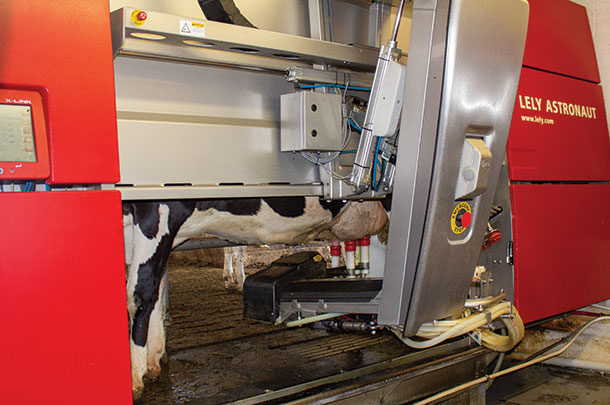The first robotic milker was installed on a dairy farm almost 30 years ago; this technology is relatively new compared to the thousands of years cows have been utilized for milk production. Reducing milking frequency before dry-off in robotic milking facilities satisfies both the animal welfare and economic components of making a new management decision, and further evaluating gradual dry-off strategies may help better understand and fully harness the role of milking robots in the process.
Research has demonstrated the advantages of gradual dry-off compared to abrupt dry-off strategies, including reduced rates of intramammary infections. Gradual dry-off systems cut down the number of milkings per day before dry-off, lowering milk production. Abrupt dry-off methods are typically used on cows toward the end of their lactation to accomplish a dry period of a set length. While abrupt dry-off is used in almost 75% of dairy herds in the U.S., dairy welfare concerns have risen regarding increased pressure and discomfort in the udder post-dry-off with this method. Udder pressure and milk leakage can be mitigated in high-producing dairy cattle by reducing milk yield before dry-off. Typically, feeding lower-energy diets toward the end of lactation sends cows into a negative energy balance, resulting in decreased milk production. With the growing popularity of milking robots, it may be possible to reduce milking frequency before dry-off instead of or in addition to feeding a lower-energy diet to limit milk production.
Traditional milking parlors are typically not designed to easily lower the milking frequency of select cattle. However, milking robots can be programmed to deny entry to cows leading up to dry-off, giving the farmer more control of milking frequency. A study conducted in Denmark, published in the October 2021 issue of the Journal of Dairy Science, indicated that restricting access to milking robots effectively lowers milk yield. The researchers observed that the most efficient way to reduce milk yield is by combining an energy-restricted diet with reduced milking frequency. Additionally, the amount of grain offered at the time of milking could be limited to further expedite the drop in milk production before dry-off. Feeding energy-restricted diets send cows into a negative energy balance, so it is essential to consider the metabolic and welfare consequences when making ethical management decisions.
In addition to health and welfare improvements for cattle, reduced milking frequency before dry-off presents economic benefits to the producer. A cow that is producing less milk consumes less feed. The University of Florida estimated these feed cost savings and the savings from reduced mastitis incidences could save a producer $29 per cow compared to abrupt dry-off. Reduced milking frequency also allows for improved mammary involution, which is the process the udder undergoes during the dry period to prepare for the next lactation. Sufficient mammary involution may also allow for added economic benefits in the subsequent lactation.
Implementing gradual dry-off strategies using robots to reduce milking frequency may also allow producers to utilize selective dry-off therapy. Cows producing less at dry-off will leak less post-dry-off than high producers. This allows a better keratin plug to form in the teat more quickly, giving the cow the best natural protectant against intramammary infections. If cows have a better keratin plug after dry-off, the need for dry-off antibiotics may be reduced. More research needs to be done to learn the impacts of a combination of selective dry-off therapy and gradual dry-off strategies on intramammary infections.
Another dry-off strategy that must be considered when deciding the best on-farm management practice is the use of a prolactin inhibitor. Prolactin inhibitors prevent prolactin production, a hormone essential in milk production. These injections can be given after the last milking before dry-off and are typically used with abrupt dry-off strategies to decrease milk leakage post-dry-off. The study mentioned above also tested a prolactin inhibitor and found that while it decreased milk leakage post-dry-off, it decreased dry matter intake (DMI) for a full day afterward, sending cows into a negative energy balance. Although prolactin inhibitors can help prevent mastitis cases when used with abrupt dry-off, the University of Florida estimated this difference is not great enough to make up for the cost of the injection itself or the labor it takes to administer it.
When making a management decision, it is essential to consider dairy welfare and the bottom line, but also what is feasible for that particular farm. Gradually reducing milking frequency is a viable option for farms milking with robots but may not be an option for those milking with a traditional parlor. Gradual dry-off may benefit farms milking with robots, as it can reduce milk production and milk leakage post-dry-off while keeping the cow in a positive energy balance and cutting down costs for the farmer.
References omitted but are available upon request. Click here to email an editor.






